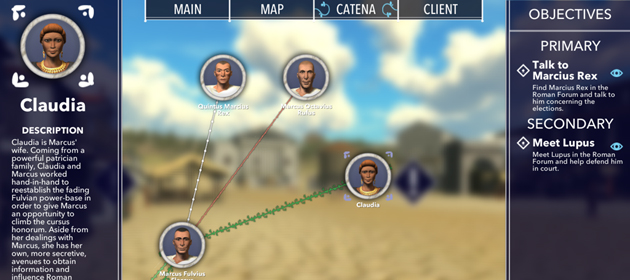
What is Saeculum?
Saeculum is our project name for the game we’re building as the core for an online and blended, full-semester course offered at the University of Arkansas, CLST 1013: Introduction to Classical Studies: Rome. It is a game designed to teach students about ancient Rome, for credit at the university level. In constructing Saeculum, Tesseract has put together a team that includes full-time studio leads, graduate students, and undergraduate interns. We also work closely with instructional designers and staff from the University of Arkansas Global Campus.
Saeculum was initially offered in fall, 2015 as a fully online course to 144 students. We learned a lot from this initial offering, and in part this blog series documents our process of revising the game and course in response to feedback from that initial offering. As an iterative development project that produces a game that gets played by at least 100-200 students per year, Saeculum has a sustained engagement with the many questions surrounding gaming and teaching other or past cultures. Some of these questions are more theoretical (e.g. how to model or simulate roughly systematic cultural behavior through game systems), and others are more pedagogical (how to balance student intern time between research and asset creation...the one teaching them a lot of valuable 3D skills, the other teaching them a lot about Rome). Many of these questions are the subject of extended, sometimes heated discussion in the Tesseract studio--e.g. the appropriate balance between fidelity to the actual spaces and archaeological evidence from Rome versus the scale and features that would produce the most compelling game play. Yours truly has often been on the losing side of this one, and in the process hopefully learned a valuable lesson: the game and its virtual environment do not have to be literally accurate in order to teach “accurately.”
Capturing 3D data from past buildings and artifacts and then visualizing the results is a technically complex task, and essential for documenting, conserving, and interpreting specific sites. But in our view, using games to teach a past culture brings its own conceptual complexity, and raises questions that often are not really approachable through a scientific methodology, either at the level of data capture and modeling or at the level of interpretation. Getting at these questions through game play may involve trading off literal accuracy for more conflicted and polyvalent thinking about how this culture worked--and how it might have “felt.” Which is to say that this project lies at a particularly interesting intersection between archaeology, cultural theory, and history. Some of the evidence for Rome is textual, some is epigraphic, some art historical, and some archaeological. So the project really demands disciplinary synthesis, as it negotiatiates between something like visualization based on data and something like cultural representation through game play. They are not the same, and the one is not secondary to the other.
It is also absolutely true that for us, necessity (the 98% of evidence for Rome we don’t have) is the mother of invention (a Rome that needs to look sort of 100%). Therefore, a key learning goal for us is that students be able to critique the plausibility of those inventions.
At the end of the day, this game has to play (a host of technical questions and challenges), be fun (how does “fun” get made in games?), and teach (especially critical thinking about what Rome was like and about how evidence of different kinds gets used to construct the past). This blog series traces our working through of the many issues associated with these three key requirements.

